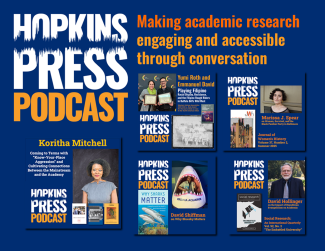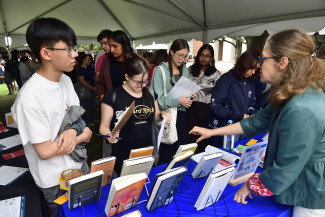
Johns Hopkins UniversityEst. 1876
America’s First Research University
Now Browsing:
Meet us in Denver: Association for the Study of Higher Education
If you are in Denver for the ASHE annual meeting, be sure to stop by to meet our staff, browse our latest publications, and take advantage of special meeting discounts. Throughout the meeting and after, JHUP books will be available at a 30% discount when your use the discount code HNAF. Check out what’s new and recent from JHUP in education and related fields!
 The 160-Character Solution
by Benjamin L. Castleman
The 160-Character Solution
by Benjamin L. Castleman
 The 160-Character Solution
by Benjamin L. Castleman
The 160-Character Solution
by Benjamin L. Castleman
For decades schools have invested substantial resources in boosting educational outcomes for disadvantaged students, but those investments have not always generated positive outcomes. Although many communities have expanded school choice, for example, families often choose to keep their children in failing schools. And while the federal government has increased the size of Pell Grants, many college-bound students who would be eligible for aid never apply. Then there is the troubling trend of “summer melt,” in which up to 40 percent of high school graduates who have been accepted to college, mostly from underserved communities, fail to show up for the fall semester.
In The 160-Character Solution, Benjamin L. Castleman shows how insights from behavioral economics—the study of how social, cognitive, and emotional factors affect our decisions—can be leveraged to help students complete assignments, perform to their full potential on tests, and choose schools and colleges where they are well positioned for success. By employing behavioral strategies or “nudges,” Castleman shows, administrators, teachers, and parents can dramatically improve educational outcomes from preschool to college.
Castleman applies the science of decision making to explain why inequalities persist at various stages in education and to identify innovative solutions to improve students’ academic achievement and attainment. By focusing on behavioral changes, Castleman demonstrates that small changes in how we ask questions, design applications, and tailor reminders can have remarkable impacts on student and school success.

Designing the New American University
By Michael M. Crow and William B. Dabars
 Palace of Ashes
by Mark S. Ferrara
Palace of Ashes
by Mark S. Ferrara
 Breakpoint
by Jon McGee
Breakpoint
by Jon McGee

America’s research universities consistently dominate global rankings but may be entrenched in a model that no longer accomplishes their purposes. With their multiple roles of discovery, teaching, and public service, these institutions represent the gold standard in American higher education, but their evolution since the nineteenth century has been only incremental. The need for a new and complementary model that offers accessibility to an academic platform underpinned by knowledge production is critical to our well-being and economic competitiveness.
Michael Crow, president of Arizona State University and an outspoken advocate for reinventing the public research university, conceived the New American University model when he moved from Columbia University to Arizona State in 2002. Following a comprehensive reconceptualization spanning more than a decade, ASU has emerged as an international academic and research powerhouse that serves as the foundational prototype for the new model. Crow has led the transformation of ASU into an egalitarian institution committed to academic excellence, inclusiveness to a broad demographic, and maximum societal impact.
In Designing the New American University, Crow and coauthor William B. Dabars—a historian whose research focus is the American research university—examine the emergence of this set of institutions and the imperative for the new model, the tenets of which may be adapted by colleges and universities, both public and private. Through institutional innovation, say Crow and Dabars, universities are apt to realize unique and differentiated identities, which maximize their potential to generate the ideas, products, and processes that impact quality of life, standard of living, and national economic competitiveness. Designing the New American University will ignite a national discussion about the future evolution of the American research university.
 Palace of Ashes
by Mark S. Ferrara
Palace of Ashes
by Mark S. Ferrara
Winner, 2015 PROSE Award in Sociology and Social Work
In addition to possessing the world’s largest economies, China and the United States have extensive higher education systems comparable in size. By juxtaposing their long and distinctive educational traditions, Palace of Ashes offers compelling evidence that American colleges and universities are quickly falling behind in measures such as scholarly output and the granting of doctoral degrees in STEM fields. China, in contrast, has massed formidable economic power in support of its universities in an attempt to create the best educational system in the world.
Palace of Ashes argues that the overall quality of U.S. institutions of higher learning has declined over the last three decades. Mark S. Ferrara places that decline in a broad historical context to illustrate how the forces of globalization are helping rapidly developing Asian nations—particularly China—transform their major universities into serious contenders for the world’s students, faculty, and resources.
Ferrara finds that American institutions have been harmed by many factors, including chronic state and federal defunding, unsustainable tuition growth, the adoption of corporate governance models, adjunctification, and the overall decline of humanities education relative to job-related training. Ferrara concludes with several key recommendations to help U.S. universities counter these trends and restore the palace of American higher learning.
 Breakpoint
by Jon McGee
Breakpoint
by Jon McGee
The challenges facing colleges and universities today are profound and complex. Fortunately, Jon McGee is an ideal guide through this dynamic marketplace. In Breakpoint, he argues that higher education is in the midst of an extraordinary moment of demographic, economic, and cultural transition that has significant implications for how colleges understand their mission, their market, and their management.
Drawing from an extensive assessment of demographic and economic trends, McGee presents a broad and integrative picture of these changes while stressing the importance of decisive campus leadership. He describes the key forces that influence higher education and provides a framework from which trustees, presidents, administrators, faculty, and policy makers can address pressing issues in the aftermath of the Great Recession.
Although McGee avoids endorsing one-size-fits-all solutions, he suggests a number of concrete strategies for handling prospective students and developing pedagogical practices, curricular content and delivery, and management structures. Practical and compelling, Breakpoint will help higher education leaders make choices that advance their institutional values and serve their students and the common good for generations to come.
Login to View & Leave Comments
Login to View & Leave Comments


